《当代汉语诗歌走向世界》
近来,我国百科诗派的诗集被诸多国外著名图书馆收藏。入选作者之一的浙江诗人王自亮日前就此事回答了本刊的提问——

国外著名图书馆部分收藏证书,从左到右分别是美国国会图书馆、俄罗斯国立图书馆、意大利使馆、法国国立大学图书馆、爱丁堡大学图书馆、哈佛燕京图书馆收藏函
The documents above are from libraries of foreign countries that certify that books of poems by poets of encyclopedic poetry of China are in their respective collections.
近来,我国百科诗派的诗集被诸多国外著名图书馆收藏。百科诗派是当代文坛智库型诗歌流派,由潜身于文史理工领域的诗歌作者组成,主要从事史诗、长诗、大型系列组诗创作和从内容到体裁的实验。以学术、智性、涵容、洞察的姿态亮相。浙江省有一位作者入选——浙江工商大学的王自亮教授。王自亮从1978年就读于杭州大学中文系时就开始诗歌创作,参加过1982年第二届“青春诗会”,40年来出版了《狂暴的边界》《将骰子掷向大海》《冈仁波齐》《浑天仪》等6本个人诗集,发表了诸多随笔、诗歌批评、艺术批评等文字,其诗歌多次获奖,最近他的长诗《上海》获第二届江南诗歌奖。他的部分诗歌被翻译成英文和西班牙文。日前,王自亮接受了本刊专访。以下是采访问答录:
问:作为汉语诗人,您是怎么看待汉语诗歌走向世界的?诗人在文化交流中应该是个什么样的角色?
答:站在东西方文化对话与交融的角度,我认为,诗人首先应该是个文化使者。为什么这么说呢?因为自新诗诞生以来,汉语诗歌发展趋势是与世界文明进程同步的。中国诗人与世界其他国家的诗人一起,既分享自由、进步和变化带来的好处和开放社会所展示的广阔文化视野,也承受着社会转型、撞击和逆袭带来的痛楚,包括恐怖主义、气候危机和资源衰竭等。世界文明是个整体,谁也离不开谁,包括诗人在内的任何知识界和文化界人士都无法置身事外。早在上个世纪初期,苏俄著名诗人曼德尔斯塔姆,就以世界文明的使者为己任。这个被称为“文明的孩子”的人,“喜欢在平凡中创造奇迹,力图对远古文明,如古希腊、古埃及、古印度等文化的积淀进行综合,系统地研究和探索它们之间深层的联系,把时间当作空间的第四维度,通过对历史、神话的朦胧回忆,来领悟现实的生活,追求石头般可感可触的冷静、坚硬与持久,在对历史的词语中实现自我的精神还原”。[1]按照著名诗人布罗茨基的说法,“不是说曼德尔斯塔姆是一个‘文明化的人’;不如说,他是为文明和属于文明的人。有一次他被要求解释他所属的文学运动阿克梅派的定义,他回答说:‘对一种世界文化的乡愁’。”[2]依我的理解,世界文化的使者,实际上所做就是从整体上传承、反思和扬弃文明社会的诸多事物,包括人和物质、生活与精神、回归和进化;与此同时,在传播思想文化、探索艺术形式和超越现时代状态等方面,做出应该有的艺术奉献,同时对人性、心灵和自我,作出诗人的追寻和回答。当然,这一切都应该是通过语言、潜意识和象征等现代后现代艺术探究,并通过诗歌文本和文学活动来达致目标。即使是那些标榜“唯美”和“诗到语言为止”的诗人和诗歌批评家,也希图与更大范畴的“他者”交流,并传播自己的文学观念、审美意识和文本,并没有一刻停止过企图获得读者或同行的理解。传播、接受、阐释、理解和对话,就是文化使者要做的工作。诗人作为文化使者,是“盗火者”、思索者、预言者,更是个超越者。
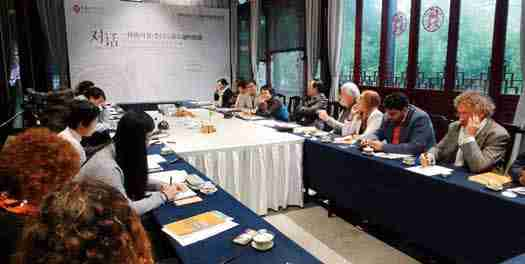
2016国际诗人扬州瘦西湖虹桥修契活动中外诗人对话。
International poets meet at a springtime event by Rainbow Bridge on the Slender West Lake in Yangzhou in 2016.
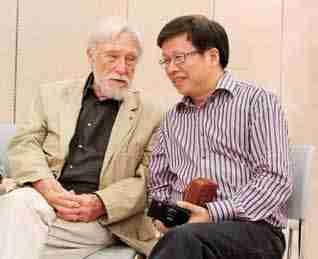
王自亮2012年4月在香港与美国诗人施耐德(左)交谈。
Wang Ziliang talks with an American poet in Hong Kong in April 2012.
问:您参加过哪些诗歌活动,与国际诗人有过交流吗?您觉得近些年中国诗人与国际诗人之间的交流形式和内容有什么特点?
答:我最近几年与国际诗人的交流主要还是在国内诗歌活动中,如唐晓渡、杨炼主持的“国际诗人扬州瘦西湖虹桥修契”、杨炼主持的“上海国际诗歌节”、北岛主办的“香港诗歌之夜杭州站”等。在活动中我认识了不少国际著名诗人和批评家,交流也很顺畅,对诗人、诗歌文本和诗学问题的探讨很深入。印象特别深刻的是2016年参加“国际诗人扬州瘦西湖虹桥修契”活动,当时主办方邀请了包括我在内的6位汉语诗人,也邀请6位西班牙语诗人。活动借助中国传统诗歌文化活动的形式——虹桥修契,同时植入国际诗歌元素,以传统修契、诗歌朗诵、对译切磋、诗学研讨、中外诗人对话等形式,将国际诗人之间的交流推进到一个新颖、精到和多样的境地。我的一首发表于1986年的诗歌,叫《舟欲行时》,由著名翻译家赵振江先生翻译成西班牙语,而西班牙语诗人胡安·卡洛斯·梅斯特雷拿出自己的诗歌《大象墓地》汉译本,进行汉语-西班牙语对译,逐字推敲,整体观照,从用词、诗艺、意象和有机构成等角度,都做了详尽的探究。我不懂西班牙语,胡安·卡洛斯·梅斯特雷也不懂汉语,但有翻译大家赵振江先生的细致、耐心和周到的传达,我和这位西班牙语诗人的交流很有效,我们双方都所获甚多,有的已经转化为一种新的能量和诗学认知。我本来就很喜欢西班牙语诗歌,以前都通过汉译,这次是面对面交流,对我认识西班牙语诗歌的特质和魅力很有助益。我相信胡安·卡洛斯·梅斯特雷也会对汉语诗歌有新的感受。
问:听说您和国内其他一些优秀诗人的诗集被好多国家图书馆所广泛收藏,能否介绍一下这件事的基本情况?
答:自2017年6月起至2018年3月为止,我和百科诗派其他成员的诗集,已相继被美国、英国、俄罗斯、新西兰、德国、荷兰、爱尔兰、法国、墨西哥、芬兰、新加坡、葡萄牙、比利时、奥地利、瑞典、挪威、瑞士、澳大利亚、波兰、意大利、捷克、加拿大、巴西、智利等一百余家国家级图书馆、世界名校图书馆及大使馆收藏。其中包括大英图书馆(英国国家图书馆)、美国国会图书馆及俄罗斯、捷克、挪威、法国的国家图书馆等。收藏频次最高的是“百科诗派创派十周年年鉴”系列,包括殷晓媛《播云剂》、海上《隐秘图腾:琥珀星》、山水如歌《潘洛斯阶梯上的蚂蚁》、浪激天涯《超弦之玄》和我的《浑天仪》。除此之外,还有殷晓媛的长诗“前沿三部曲”、我的《将骰子掷向大海》和《冈仁波齐》、向以鲜《我的孔子》《唐诗弥撒曲》、孙谦《人马座升空》、盘予《光。产卵》、杨政《苍蝇》等,以及百科诗派独立设计的“2018人工智能纸魔方”。在这里要特意介绍一下这个包含6国语言的“魔方”:每一页使用86种源自大和色谱精选标准色彩,介绍100位对百科诗派写作影响最大的世界级大师,可扫码阅读70条来自《科学》《自然》《细胞》《国家地理》《福布斯》《今日美国》等全球顶级杂志的前沿新闻,还暗藏72个代表人类史上标志性历史日期的二进制码。这是百科诗派跨界探索的成果之一。众多收藏机构对百科诗派给以极高的评价。俄罗斯国家图书馆采编部部长T.V.彼得鲁先科先生,将百科诗派著作誉为“横贯当代中国诗坛的百科诗学主义之强流”;多米尼加国家图书馆馆藏发展部部长Glennys Reyes Tapia则称百科诗派著作为“博大文化代表、书志编纂研究瑰宝”。“百科诗派创派十周年年鉴”是这一流派在重构诸多学科的跨文体、多语言先锋写作尝试中的重大事件之一。百科诗派成员还受邀参加法国文化部赞助的“诗人之春”(Le Printemps des Poètes)等国际诗歌活动,以及独立翻译20世纪最著名的建筑大师、“功能主义之父”勒·柯布西耶诗集《直角之诗》。2018年1月,包括我的诗集《浑天仪》在内的“百科诗派创派十周年年鉴”图书,在位于巴黎第三区Boulevard de Sébastopol 72号La librairie le Phénix(凤凰书店)正式发售。
问:您的诗歌翻译成外语的情况如何?有无出版计划?
答:我的诗歌,有一部分已经翻译成英语和西班牙语。其中诗人、翻译家阿九、殷晓媛出力甚多。我的诗歌英译工作还在进行中。诗人、著名翻译家海岸也准备翻译我的另一部分诗歌。我们还会找一些英语国家的汉学家、诗人,来对我的诗歌英译本进行润色和订正。我打算在今明两年内,出一本自己的汉英双语诗选。今后还会出英译诗集,特别是争取让国外的出版社出我的诗集。我会与翻译家们共同合作,把这件有意义的事做好。在国际文化交流过程中,翻译起到的作用居功厥伟。当代汉语诗歌走向世界任重道远,我们应当加倍努力。
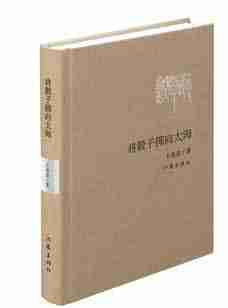
王自亮作品。
A book by Wang Ziliang
[1]《曼杰什坦姆诗全集·译序》,汪剑钊,东方出版社,2008年版,北京。
[2]《文明的孩子》,见《小于一》,约瑟夫·布罗茨基著,黄灿然译,浙江文艺出版社,2014年版,杭州。
Rediscover Modern Chinese Language
A Chat with Wang Ziliang, a Representative Author of Encyclopedic Poetry By Chen Ji
Recent years saw the powerful rise of ‘encyclopedic poetry’ in the literary world of China. “Encyclopaedism”, which has been turned into an ideological trend of contemporary Chinese poetry, emphasizes elitism, intellectualism, comprehensiveness, intertextuality and multiculturalism. Founded by epic poet Yin Xiaoyuan in 2007 and supported by an independent, freelance literary group, the new trend is often mentioned as “avant-garde” and experimental. The members of the ‘club’ include maverick, innovative, tradition-defying epic poets, novelists and trans-genre writers engaged in “encyclopaedism” experiments in themes, styles and techniques. All these people are meanwhile experts in arts or science as their social identities. One of the key members is Wang Ziliang, whose passion in poetry writing was lit up in his undergraduate years in the Chinese Department of Hangzhou University four decades ago. Having published six poetry collections and seen many of his works translated into English and Spanish, he recently won an award at the 2nd Jiangnan Poetry Competition for his long poem Shanghai.
The following is a summary of a question & answer session between Cultural Dialogue and Wang.
Q: What are your thoughts about the position of the Chinese poetry in the global literary arena? And what role do you think the Chinese poets should play?
A: From the perspective of east-and-west cultural communication, first of all, a poet should be a cultural ambassador. The development of modern Chinese poetry since its birthday has been running synchronously with the world’s civilization progress. Poets worldwide have been sharing the benefits of all the social progresses that have taken place as well as the accompanying sufferings such as terrorism, climate crisis and resource depletion. In fact, no one living in this world can stay aloof from the affair. Osip Mandelshtam, one of the foremost members of the Acmeist school of poets, dedicated his life to such a role, working wonders from triviality and painstakingly exploring deeper connections between different cultures. Time, in his eyes, was the fourth dimension of the world. He spent his lifetime making connections with history to see the truth of reality and return to his spiritual roots. Acmeism, or the Guild of Poets, is “a reminiscence of the world culture”, Joseph Brodsky, a Russian and American poet and essayist, once pointed out when asked to explain the mission of the transient poetic school.
As far as I can understand, the nucleus of the responsibilities of a cultural ambassador is to inherit, reflect and sublate, and to pursue the ultimate answers about human nature. All this cannot be realized without the function of postmodernist art that takes the form of languages, subconscious and symbolism. In this process, poetry and literary activities play a critical role. Even the extremists among poets and critics are eager to express, communicate and be understood by readers and peers. In a word, the duty of a cultural ambassador is to talk with the world. A poet is a fire stealer, a predictor, a thinker and a transcender.
Q: How do you feel about your communication with poets from other countries?
A: Most of such communication in recent years was from activities I took part in China, such as the international poetry festivals in Yangzhou, Shanghai and Hangzhou. I made a lot of new like-minded friends, and the communication was smooth and inspiring. I was one of the six Chinese poets taking part in the Yangzhou gathering that also drew participation from six Spanish-speaking poets. The event’s elaborately designed traditional Chinese elements added enormous flair to the atmosphere. There was a thrill of ‘dialogue’, achieved by a brainstorming session in which Spanish poet and visual artist Juan Carlos Mestre and I enjoyed an inspiring chat with the assistance of the interpretation by famous translator Zhao Zhenjiang. The communication generated new energy and deepened my perception of the art of poetry; and I believe Juan Carlos Mestre felt the same way after the dialogue.
Q: Many collections of works by ‘Encyclopaedists’, including several of yours, have been collected by famous libraries worldwide. How do you feel about this?
A: Since June 2017, our works have found their way into world-famous libraries and embassies in more than 100 countries including the British Library, Library of Congress and Bibliothèque Nationale de France. The most heavily collected is the Encyclopaedists Yearbook that includes a cycle of representative works by Encyclopaedists. The yearbook is a new milestone set by Encyclopaedists in their cross-genre, multilingual exploration. A book release ceremony was held at the La librairie le Phénix on Boulevard de Sébastopol in Paris in January 2018. The “2018 AI Rubik’s Cube” is also worth mentioning. The elaborately designed multilingual ‘cube’ introduces 100 world-class masters whose influences shaped encyclopaedists into what they are today. The ‘cube’ allows the reader to browse 70 news stories from top-notch magazines such as Science, Nature and National Geographic and includes 72 enciphered binary codes that indicate the most important landmarks in human history. “Encyclopaedists” have drawn the attention from the Ministry of Culture of France and took part in a good many international poetry events such as Le Printemps des Poètes. Encyclopaedists were invited to translate Poème de l’angle Droit, a poem collection by Franco-Swiss architect Le Corbusier, regarded as the founding father of functionalism.
Q: Have you seen many of your works translated into other languages and published?
A: Some of my works have been translated into English and Spanish, for which I owe many thanks to famous translator and poet A Jiu and Yin Xiaoyuan. Translation for some other works is in progress. One of the plans is to work with sinologists and poets in English-speaking countries to polish the translation to get ready for the publishing of a bilingual collection at some point this year or next year. The importance of translators in cross-cultural exchange cannot be overestimated. We still have a long way to go before seeing modern Chinese poetry embraced by a global audience.
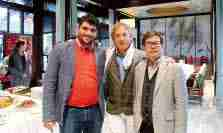
2016国际诗人扬州瘦西湖虹桥修契活动期间,王自亮与西班牙语诗人胡安·卡洛斯·梅斯特雷、古巴诗人亚瑟夫·阿南达·卡尔德隆合影。
Wang Ziliang poses with a Spanish poet and a Cuban poet for a picture at a springtime event by the Rainbow Bridge on the Slender West Lake in Yangzhou in 2016.
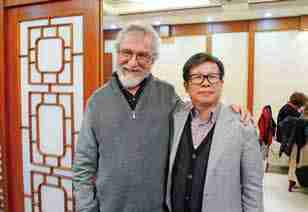
2016国际诗人扬州瘦西湖虹桥修契活动期间,王自亮与西班牙语诗人安东尼·德尔特罗合影。
Wang Ziliang poses with a Spanish poet for a picture at a springtime event by the Rainbow Bridge on the Slender West Lake in Yangzhou in 2016.